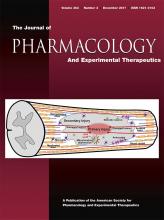Abstract
An improved understanding of the endocannabinoid system has provided new avenues of drug discovery and development toward the management of pain and other behavioral maladies. Exogenous cannabinoid type 1 (CB1) receptor agonists such as Δ9-tetrahydrocannabinol are increasingly used for their medicinal actions; however, their utility is constrained by concern regarding abuse-related subjective effects. This has led to growing interest in the clinical benefit of indirectly enhancing the activity of the highly labile endocannabinoids N-arachidonoylethanolamine [AEA (or anandamide)] and/or 2-arachidonoylglycerol (2-AG) via catabolic enzyme inhibition. The present studies were conducted to determine whether such actions can lead to CB1 agonist–like subjective effects, as reflected in CB1-related discriminative stimulus effects in laboratory subjects. Squirrel monkeys (n = 8) that discriminated the CB1 full agonist AM4054 (0.01 mg/kg) from vehicle were used to study, first, the inhibitors of fatty acid amide hydrolase (FAAH) or monoacylglycerol lipase (MGL) alone or in combination [FAAH (URB597, AM4303); MGL (AM4301); FAAH/MGL (JZL195, AM4302)] and, second, the ability of the endocannabinoids AEA and 2-AG to produce CB1 agonist–like effects when administered alone or after enzyme inhibition. Results indicate that CB1-related discriminative stimulus effects were produced by combined, but not selective, inhibition of FAAH and MGL, and that these effects were nonsurmountably antagonized by low doses of rimonabant. Additionally, FAAH or MGL inhibition revealed CB1-like subjective effects produced by AEA but not by 2-AG. Taken together, the present data suggest that therapeutic effects of combined, but not selective, enhancement of AEA or 2-AG activity via enzyme inhibition may be accompanied by CB1 receptor–mediated subjective effects.
Footnotes
- Received August 1, 2017.
- Accepted September 14, 2017.
This research was supported by the National Institutes of Health National Institute on Drug Abuse [Grants K01-DA035974 (to B.D.K.) and R01-DA035857 (J.B.)].
- Copyright © 2017 by The American Society for Pharmacology and Experimental Therapeutics
JPET articles become freely available 12 months after publication, and remain freely available for 5 years.Non-open access articles that fall outside this five year window are available only to institutional subscribers and current ASPET members, or through the article purchase feature at the bottom of the page.
|






